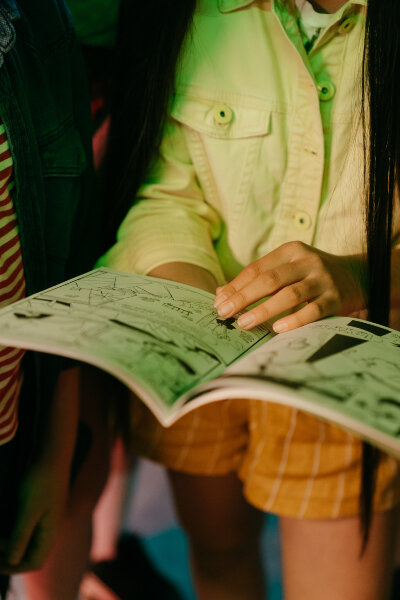We don't really think of it much as we go on our day to day, but art is an indispensable part of our lives. Throughout history, it has become a mirror to our souls that can spur us to reflect on and perhaps change our lives. Arguably, it serves the same expressive purpose for all. Despite that, not all art forms are recognised equally. Traditional art will always be held in high regard, displayed in museums and etched in our history books but popular art forms might not be as appreciated in some circles or even be regarded as art at all. Still, despite these tensions, a lot of these forms still manage to thrive. Ahead, we explore popular art that manages to thrive despite their tricky positions in the changing landscape of the arts.
(Un)popular literature
The romance genre is a favourite for many, including Filipino author Mina V. Esguerra. She grew up reading witty novels that deal with love, and thus, for the past 11 years, she has been writing her own happily ever afters. To her, the charm lies in taking the tropes we've come to enjoy in foreign books and making it into something that resonates with the local readers. "I'm still so excited by the prospect of taking another trope and making it my own," she shared.
While Mina noted that the genre is the most purchased in the bookstore, it's still not quite getting the recognition it deserves and is usually brushed off by conservatives in the Philippine literary scene. "The discrimination is systemic, and is not just instances of people being snobs," Mina pointed out. She noted how romance authors are not invited to teach at literary conferences, how they're excluded at literary awards, and how they're usually not granted scholarships and grants. "That’s discrimination and perpetuated not just by individual snobs but by the industry, the academe, and other literary communities."
Creating a hybrid of forms
Similarly, graphic novels and comics are also subject to such treatment. It stands out to many as it marries visual arts with the conventions of narrative storytelling but it's having a hard time finding its place in the visual arts and literary scenes. Malaysian comic artist Jonsuraya recounted a moment in her Master's studies that relates to this: "A professor mentioned that comics are considered 'low art', as opposed to fine art such as paintings and sculptures and comics, does not have the same value as other forms of art."
She has been drawing comics since she was little, so of course, the comment felt personal to her. But instead of viewing comics' hybrid nature as a downside, Jonsuraya finds that that is its greatest strength. To her, it's the most accessible and relatable as "the combination of visuals and texts helps to deliver messages and stories better."
The struggle for public art
Speaking of visual arts, another that struggles to get the recognition it deserves is street art. While sighting a vibrant mural splashed across grey walls of the city is a breath of fresh air, street art isn't as valued as the more traditional forms of visual art. Not to mention, because it makes use of limited public spaces as its medium, there are a lot of questions about its legality.
But Singaporean artists like Nadirah Abdul Razak of visual art duo Ink & Clog find street art as a way to push boundaries and cross the gap between the artist and the audience. For her, "the whole concept of creating murals was to share the visual aspects and message across the public and enabling them to decipher the artwork in endless possibilities — a form of collaboration between the artists and their viewers." Studio Moonchild's Anastasia Catharina echoed the sentiment, saying: "Not only does it stand out more, [but it also] has the potential to make passers-by happy and entertained. This medium also makes me realise I can inspire others through murals."
Thriving through the tensions
There are a lot of critics that try to put their two cents in, dictating what qualifies as art and what doesn't, but these artists, in pursuit of their passions, don't really let it get to them. Mina, for one, avoids literary circles she knows is not welcoming of them, and instead, through her #romanceclass initiative, has built a huge community where Filipino romance writers get the support they need.

Audiences who recognise the thoughtful craft of popular art help these forms thrive (Photo from: cottonbro via Pexels.com)
Jonsuraya, on the other hand, showed her grit through her dedication to her craft. While she worked as a freelance comic artist, she continued developing her artistry till she graduated in a university in Kyoto with a PhD in manga studies.
Thankfully, for street artists in Singapore, there has been an increase in spaces allowed for various people to showcase their works, and the public has become more accepting of their art. Not to mention, it helps that the local urban art scene is supportive. Despite seemingly male-dominated, the community readily welcomes women artists like Nadirah and Anastasia. As Nadirah herself puts it, "In graffiti, we don't question our gender in this game as what really matters most is our craft."
Ultimately, no matter the form, what makes these artists thrive is the support they get from their audiences. Some may deem this accessibility as a handicap that lowers the work's value, but what is art for if not to be enjoyed by everyone? In the end, the artist and the audience co-exist, inspiring one another to live and push the limits of imagination.
(Cover photo from: cottonbro via Pexels.com)
Next, here's the appeal of radio in the age of on-demand content.
Comments, questions or feedback? Email us at [email protected].








